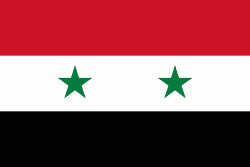Kesab (Kassab)
Kessab, Kesab, or Kasab (كسب ; Քեսապ) is a mostly Armenian-populated town in northwestern Syria, administratively part of the Latakia Governorate, located 59 kilometers north of Latakia. It is situated near the border with Turkey on the slope of Mount Aqraa, 800 meters above sea level. According to the Syria Central Bureau of Statistics, Kessab had a population of 1,754 in the 2004 census. Along with the surrounding villages, the sub-district of Kessab has a total population of around 2,500.
With its mild, moist climate and encirclement by wooded green mountains and deep valleys, Kessab is a favoured vacation resort for Syrians, mainly from Aleppo and Latakia.
Administratively, Kessab belongs to the Latakia District; one of the governorate's four Manatiq, and the centre of Kessab nahiyah sub-district. The town has around 2,000 inhabitants, mainly Armenians. The name of the town is thought to be derived from the Latin Casa Bella (i.e. the beautiful house).
The town of Kessab is 59 kilometres north of Latakia, just 1 kilometre southwest of the border with Turkey (the former Syrian province of Alexandretta), and 7 kilometers east of the Mediterranean Sea.
Located at a height ranging between 650 and 850 above sea level, in the middle of dense coniferous Mediterranean forest, the town is a summer destination for Syrian people and for foreign visitors.
Kessab is an ancient Armenian settlement, dating back to the period of the Armenian Kingdom of Cilicia. Currently, the population is mainly Armenian with a minority of Arab Alawites. The town is surrounded with minor villages and farms with a majority of Armenians, including the villages of Duzaghaj (Nab' al-Murr), Esguran, Sev Aghpyur (al-Sakhra), Chinar (al-Dilbeh), Chakaljek, Keorkeuna, Ekizolukh (Nab'ain), Baghjaghaz (al-Mushrifeh), Karadouran (al-Samra), Karadash and the abandoned village of Bashord.
The town is surrounded with many mountains including the mountains of Bashord (857 meters), Dyunag (1008 meters), Dapasa (1006 meters), Chalma (995 meters) and Sildran (1105 metres) from the west, and mount al-Nisr (851 metres) from the south. Jebel Aqra -also known as Mount Casius- at the north, located in the Turkish side next to the borderline, is the highest peak of the Kessab region, with a height of 1709 meters.
With its mild, moist climate and encirclement by wooded green mountains and deep valleys, Kessab is a favoured vacation resort for Syrians, mainly from Aleppo and Latakia.
Administratively, Kessab belongs to the Latakia District; one of the governorate's four Manatiq, and the centre of Kessab nahiyah sub-district. The town has around 2,000 inhabitants, mainly Armenians. The name of the town is thought to be derived from the Latin Casa Bella (i.e. the beautiful house).
The town of Kessab is 59 kilometres north of Latakia, just 1 kilometre southwest of the border with Turkey (the former Syrian province of Alexandretta), and 7 kilometers east of the Mediterranean Sea.
Located at a height ranging between 650 and 850 above sea level, in the middle of dense coniferous Mediterranean forest, the town is a summer destination for Syrian people and for foreign visitors.
Kessab is an ancient Armenian settlement, dating back to the period of the Armenian Kingdom of Cilicia. Currently, the population is mainly Armenian with a minority of Arab Alawites. The town is surrounded with minor villages and farms with a majority of Armenians, including the villages of Duzaghaj (Nab' al-Murr), Esguran, Sev Aghpyur (al-Sakhra), Chinar (al-Dilbeh), Chakaljek, Keorkeuna, Ekizolukh (Nab'ain), Baghjaghaz (al-Mushrifeh), Karadouran (al-Samra), Karadash and the abandoned village of Bashord.
The town is surrounded with many mountains including the mountains of Bashord (857 meters), Dyunag (1008 meters), Dapasa (1006 meters), Chalma (995 meters) and Sildran (1105 metres) from the west, and mount al-Nisr (851 metres) from the south. Jebel Aqra -also known as Mount Casius- at the north, located in the Turkish side next to the borderline, is the highest peak of the Kessab region, with a height of 1709 meters.
Map - Kesab (Kassab)
Map
Country - Syria
 |
 |
| Flag of Syria | |
The name "Syria" historically referred to a wider region, broadly synonymous with the Levant, and known in Arabic as al-Sham. The modern state encompasses the sites of several ancient kingdoms and empires, including the Eblan civilization of the 3rd millennium BC. Aleppo and the capital city Damascus are among the oldest continuously inhabited cities in the world. In the Islamic era, Damascus was the seat of the Umayyad Caliphate and a provincial capital of the Mamluk Sultanate in Egypt. The modern Syrian state was established in the mid-20th century after centuries of Ottoman rule. After a period as a French mandate (1923–1946), the newly-created state represented the largest Arab state to emerge from the formerly Ottoman-ruled Syrian provinces. It gained de jure independence as a democratic parliamentary republic on 24 October 1945 when the Republic of Syria became a founding member of the United Nations, an act which legally ended the former French mandate (although French troops did not leave the country until April 1946).
Currency / Language
| ISO | Currency | Symbol | Significant figures |
|---|---|---|---|
| SYP | Syrian pound | £ or لس | 2 |
| ISO | Language |
|---|---|
| AR | Arabic language |
| HY | Armenian language |
| EN | English language |
| FR | French language |
| KU | Kurdish language |















